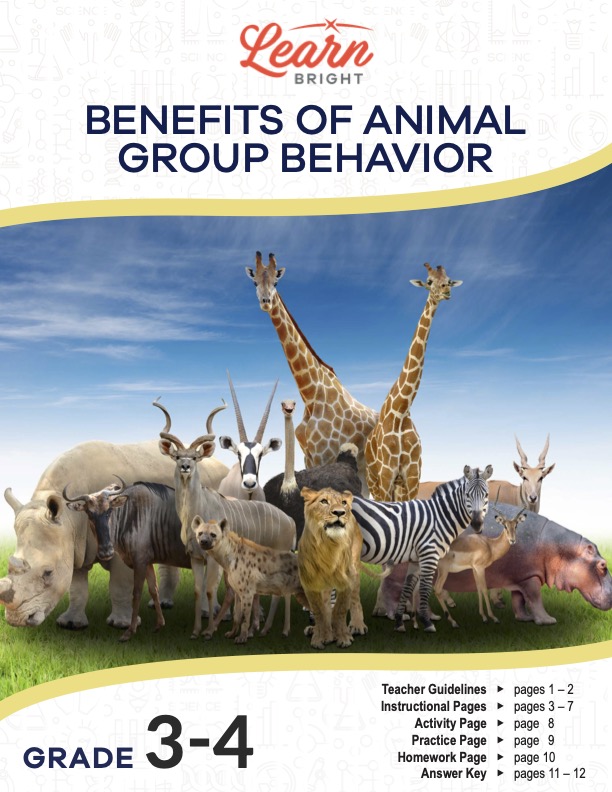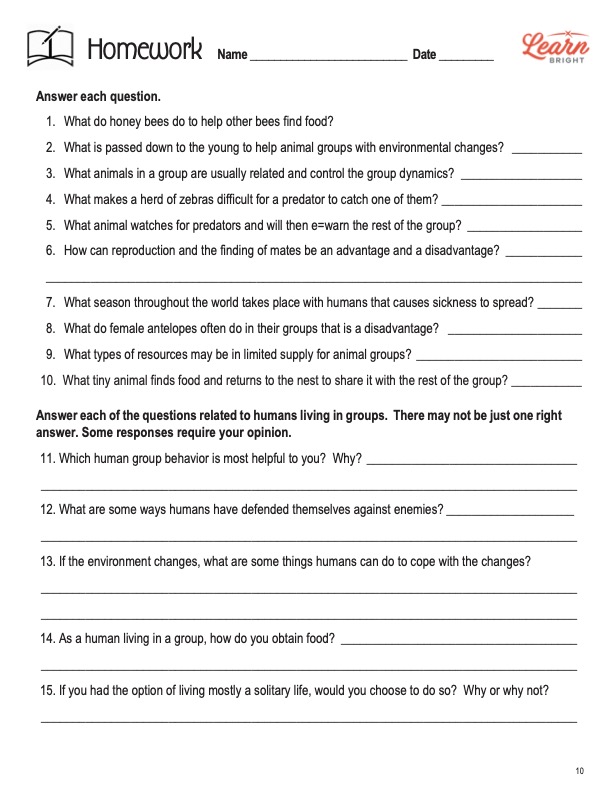Description
What our Benefits of Animal Group Behavior lesson plan includes
Lesson Objectives and Overview: Benefits of Animal Group Behavior explores the pros and cons of animals of living in a group as opposed to on their own. Students will learn about and be able to identify and list advantages and disadvantages. The lesson is for students in 3rd grade and 4th grade.
Classroom Procedure
Every lesson plan provides you with a classroom procedure page that outlines a step-by-step guide to follow. You do not have to follow the guide exactly. The guide helps you organize the lesson and details when to hand out worksheets. It also lists information in the yellow box that you might find useful. You will find the lesson objectives, state standards, and number of class sessions the lesson should take to complete in this area. In addition, it describes the supplies you will need as well as what and how you need to prepare beforehand. You will not need any other supplies other than the handouts for this lesson.
Options for Lesson
The “Options for Lesson” section of the classroom procedure page provides additional ideas for activities or alternative ways to go about the lesson. For this lesson, both ideas relate to the activity. You may want students to work alone or in groups for the activity instead of in pairs. In addition, you could have students create posters as part of the activity. If you choose to do so, you will need to provide the supplies necessary to create the posters, such as colored pencils or markers and poster paper or construction paper.
Teacher Notes
The teacher notes page provides a paragraph of extra guidance as you prepare your lesson. It suggests that you use this lesson in conjunction with other animal-related lessons. (See RELATED LESSON PLANS below for a few options.) Use the blank lines on this page to write down any other ideas or notes you have before you give the lesson.
BENEFITS OF ANIMAL GROUP BEHAVIOR LESSON PLAN CONTENT PAGES
Animals in Groups
The Benefits of Animal Group Behavior lesson plan contains five pages of content. The first page introduces the concept of social behaviors, which are the interactions that animals have with each other, both within a species and between species. The lesson outlines a few examples to help students understand the concept, such as ordering food from a server or talking with family and friends.
Just like humans, many animals live in groups. Birds fly together in flocks. Zebras and elephants travel together as a collective herd. Ants work together to find sources of food. Other animals, however, live solitary lives. In other words, they live by themselves and don’t interact with others of their kind unless it is time to mate or is otherwise necessary. For instance, polar bears and most amphibians and reptiles live by themselves.
Students will discover that, for animals, living in a group comes with many benefits. They can hunt for food together, raise their young together, and help protect each other in their various environments. There are also disadvantages, but most of the time, the pros of group living outweigh the cons.
Advantages
Animals almost always benefit from living within a group. Obtaining food is one benefit. It is unnecessary for every animal in a group to obtain food because they can share what they find with each other. A pride of lions can hunt down a single giraffe and share that food with one another. Ants do something similar in that they can obtain large pieces of food and bring it back to the nest for the other ants to share.
Additionally, animals that live in groups can more easily defend themselves from predators. Each group member shares in this responsibility. The coloration of zebras, for instance, often makes it difficult for predators to distinguish just one zebra from the rest of the herd. It is likewise easier for groups to cope with changes to their environment than it is for single animals to do the same. For example, lemon sharks patrol their environments and communicate any changes to other group members.
Students will discover that there are even more benefits to animals that live in a group. These include social interaction, more efficient movements (such as swimming or flying), and a greater availability of mates. Students may be able to recognize how some of these advantages apply to humans, such as that of social interaction. They can probably see how their social interactions with others, such as friends and family, are enjoyable and even necessary.
Disadvantages
Naturally, there can be disadvantages to living in groups as well. The four most common disadvantages are resource competition, risk of sickness, predation, and mate competition. Animals that live with each other share their resources, such as food, water, and shelter. When such resources begin to run out, there is not enough to go around. A drought, for instance, can leads animals of the same group to compete with each other for the water and food supply.
Sicknesses spread more easily when animals live close together. Herds of sheep and other farm animals are often susceptible to the spread of disease for this reason. Predation is the next disadvantage students will learn about. Predation is the preying of one animal on others, which can occur when animals travel in groups. A predator can attack a large group and likely catch at least one of its prey. Finally, all animals need to reproduce, and living in a large group can mean that it’s harder to find a mate. Animals then have to fight each other in order to win a mate.
Students will learn that there are disadvantages for people as well. During natural disasters, people often take advantage of others’ misfortune either by charging high prices for basic needs or stealing personal items from their homes. Despite the cons, there are still more benefits to living in a group than living alone.
BENEFITS OF ANIMAL GROUP BEHAVIOR LESSON PLAN WORKSHEETS
The Benefits of Animal Group Behavior lesson plan includes three worksheets: an activity, a practice worksheet, and a homework assignment. These worksheets will help students solidify their comprehension of the concepts they learned throughout the lesson. The guidelines on the classroom procedure page describe when to hand out each worksheet to the students.
ANIMAL GROUP PRESENTATION ACTIVITY WORKSHEET
For the activity, students will create a presentation for an animal group. They will work with a partner to complete the activity. You are welcome to have them work alone or in groups if you prefer. Students will use the Internet and other resources to research a species of animal that typically lives in a group. They will find out how the animals interact with each other and identify both the advantages and disadvantages. The bottom of the worksheet provides a chart with questions for students to fill out as they research their animals. When students finish their research and fill out the chart, they will present to the class what they learned.
BENEFITS OF ANIMAL GROUP BEHAVIOR PRACTICE WORKSHEET
There are two sections on the practice worksheet. The first section lists 10 statements. Students must decide whether each statement is true (T) or false (F). For the second part, students will read 10 more statements and decide whether each one is an advantage (A) or disadvantage (D) of living in a group.
ANIMALS AND HUMANS HOMEWORK ASSIGNMENT
The homework assignment is also split into two sections. The first section requires students to answer 10 questions based on what they learned during the lesson. The second section lists 5 questions that relate to the behavior of humans. Students will need to use their critical thinking skills to answer these questions.
Worksheet Answer Keys
The final pages of the lesson plan are answer keys for the practice worksheet and homework assignment. The second section of the homework assignment, however, does not include answers. This is because students’ responses will vary according to their opinions and insights. There may be incorrect answers for some of the questions, but you will need to use your judgment on a student-by-student basis. If you choose to administer the lesson pages to your students via PDF, you will need to save a new file that omits these pages. Otherwise, you can simply print out the applicable pages and keep these as reference for yourself when grading assignments.










